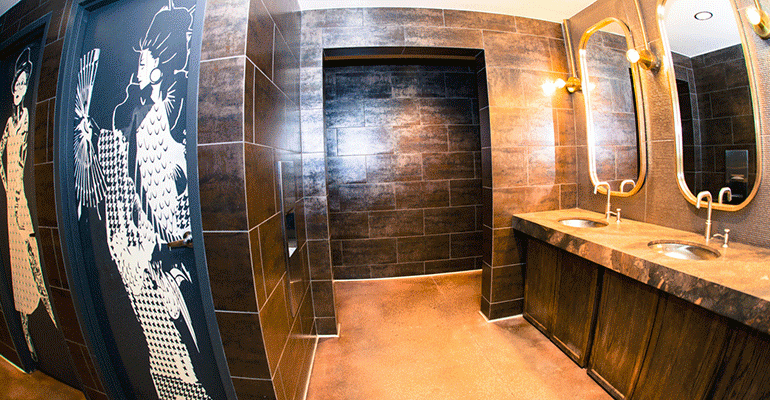Whether for space concerns or state regulations, restaurateurs have been rethinking unisex restrooms and getting creative with their design and signage.
Unisex restrooms are not new, despite the fact that we may be hearing about them more lately.
“Unisex bathrooms have been a popular choice for quite some time among smaller restaurant operators who can save square footage and construction costs by not having gender-specific facilities,” said Chuck Taylor, director of operations for national commercial contractor Englewood Construction. “In restaurants where square footage and usage only requires two restrooms, owners typically don't want to bother designating a men's and women's room, as it makes more sense from both a cost and usage standpoint to keep them gender neutral.”
Unisex restrooms can also be more user-friendly.
“It’s generally more convenient to have single-user restrooms, and they’re especially helpful for people who have children,” said Clare Marino, partner at GTM architects, which helped design the gender-neutral bathrooms at Republic in Takoma Park, Md., and Carving Room in Washington, D.C. “It’s a naturally logical starting point for developing less restrictive signage, which is good for business.”
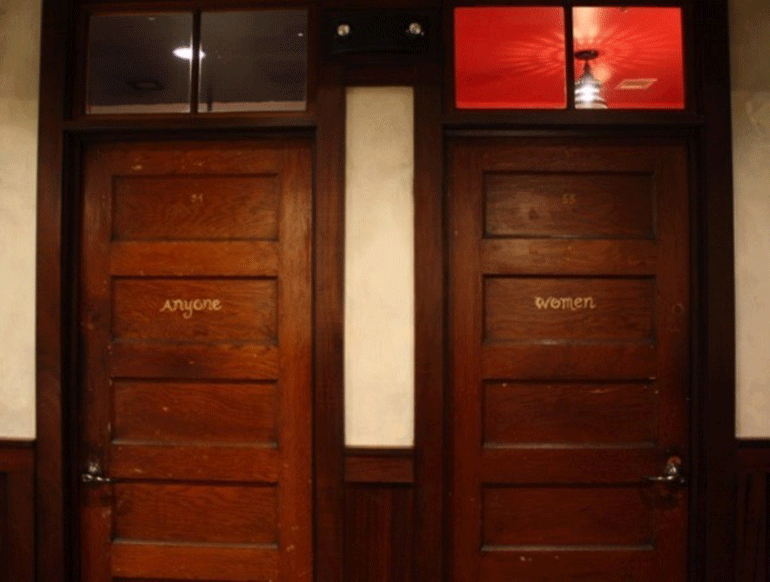
Republic in Takoma Park, Md., has a restroom for women and another for anyone.
When designing a restroom space that will be used by everyone, what’s the best route to take? Many operators go with something simple and nondescript, while others think outside the box and leave guests with a design or signage that’s a bit more memorable.
At Harlem Shake in New York City, vintage fixtures and walls plastered with old-school issues of JET magazine greet guests when they walk into the unisex bathroom that’s simply labeled “WC.”
In response to long lines at the women’s room, Republic in Takoma Park, Md., built a “women’s” room and an “anyone” room. The “anyone” room features a blown-up image of Johnny Cash’s mugshot, and the women’s room is decked out with antique hand mirrors.
At North Park Beer Co. in San Diego, three bathroom doors invite guests to “Sit,” “Stand,” or “Sit or Stand,” according to Paul Basile, principal and lead designer at Basile Studio.
“Men and women can use any of the three bathrooms,” Basile said. “One has a urinal, one has a toilet, and one is unisex. Previously, the bathrooms were going to be designated as male, female and unisex. The state law in California got passed during the construction phase, so the owner wanted to come up with a creative way to address the new issue.”
In general, Basile Studio tries to build gender-neutral restrooms in all of its projects, according to Basile. This helps with long restroom lines and keeps the design consistent.
“Everyone is making more of an effort to be creative and to make sure the restrooms relate to the style of the spaces that they’re attached to,” Marino said. “We’re coming up with artwork and light fixtures that are more creative and colorful than your standard ADA-compliant stall, although most unisex bathrooms do still have an ADA-compliance requirement.”
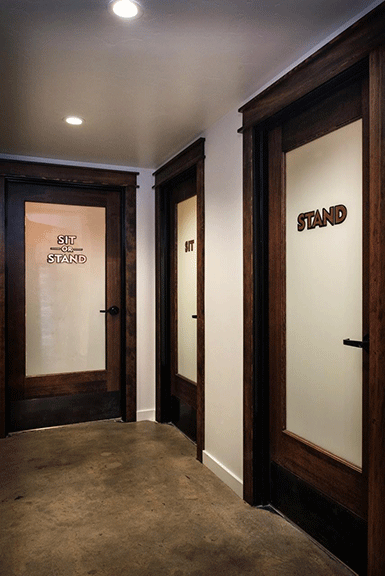
At North Park Beer Co. in San Diego, three bathroom doors invite guests to sit, stand, or sit or stand.
Fixtures and Colors
Speaking of fixtures, the humdrum stainless steel bars and knobs of yesterday have been making room for more interesting replacements.
“More unique door hardware and fixtures and grab bars that are still ADA compliant is something that we’re doing more,” Marino said. “We’re using more black iron, reflective finishes, and reproduction and antique fixtures instead of stainless steel.”
Urinals are usually requested in bars because of the volume of people and the length of time they spend in a space, according to Marino.
“There are nicer looking urinal fixtures available now that look nice in a unisex bathroom, match the decor and are easy to clean,” she said.
Guests today are open to a range of colors and patterns, Marino said.
“People aren’t going with blue and pink anymore; they’re very open to color and pattern,” she said. “The biggest challenge now is to create a space that feels open and spacious, which means incorporating full-wall mirrors, light paint colors, ample lighting and higher ceilings.”
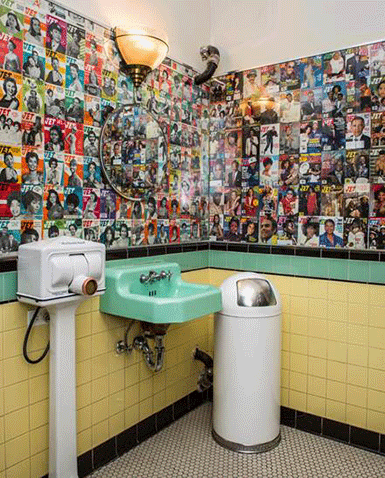
At Harlem Shake in New York City, vintage fixtures and walls are plastered with old-school issues of JET magazine.
Communal Restrooms
Some operators are going beyond the single-user restroom to ones in which guests share the same restroom with multiple stalls and sinks.
At Sake Rok in Las Vegas, a large sign simply states, “restroom.” Once inside, a restroom attendant ushers guests into the space, which has a communal sink, multiple fully enclosed stalls and no urinals, according to Sake Rok owner and CEO Albert Mack.
“Sake Rok is a fun, upbeat and lively venue, and we wanted the bathroom to have a similar vibe,” Mack said. “We incorporated clever designs of geishas and ninjas on each of the doors. On the handicap stall, there’s an image of a samurai in a wheelchair, drinking a bottle of sake and doing a wheelie.”
Mack said that for Sake Rok, the bathroom attendant is a big help.
“People who may be confused or not used to gender-neutral bathrooms are greeted and put at ease as soon as they walk in the space,” he said. “The attendant also helps keep each stall tidy and clean.”
Mack recommends bright lighting and ample space in a communal restroom setting.
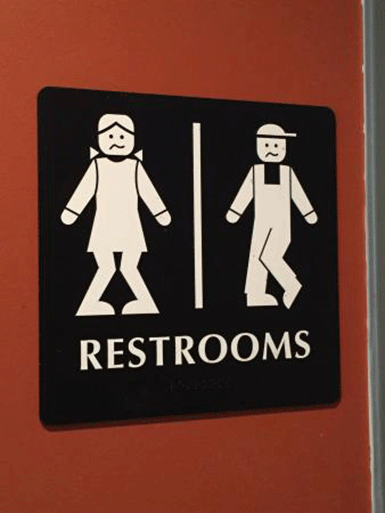
The gender-neutral bathrooms at Carving Room in Washington, D.C. were designed by Clare Marino, partner at GTM architects.
“We keep our restaurant lowly lit, but it was important to us to keep the bathroom bright. Additionally, we gave as much space as possible to the waiting and washing area, so people aren’t standing on top of each other,” he said. “These are little things, but I think they make our guests more comfortable.”
Common handwashing areas are also becoming more popular.
“That’s an approach that’s been around in Europe for decades, and I’m seeing more of that in the D.C. area as a way to accommodate privacy and accessibility at the same time,” Marino said.
Whether you’re going for funny or stylish, the general approach should be to keep things clear when it comes to restrooms, Marino said.
“Focus on good design, making the space feel large and universally appealing, and complementary to the restaurant,” she said. “The restroom shouldn’t feel like a departure from the experience.”
Correction: June 20, 2017 A quote in an earlier version of this story mischaracterized a law in California as a federal law. It is a state law.

